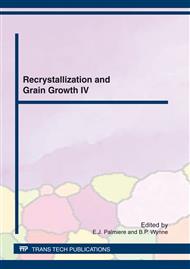[1]
F.J. Humphreys: Mater Sc & Techn. Vol. 8 (1992), p.135.
Google Scholar
[2]
J. Washburn, and E.R. Parker: Jour. Metals Vol. 4 (1952), p.1076.
Google Scholar
[3]
C.H. Li, E.H. Edwards, J. Washburn, and E.R. Parker: Acta Metall. Vol. 1 (1953), p.223.
Google Scholar
[4]
M. Winning, G. Gottstein, and L.S. Shvindlerman: Acta Mater. Vol. 49 (2001), p.211.
Google Scholar
[5]
M. Winning: Acta Mater. Vol. 50 (2003), p.6465.
Google Scholar
[6]
M. Heinrich, and F. Haider: Phil Mag. Vol. 74 (1996), p.1047.
Google Scholar
[7]
M. Ferry: Mater. Sci. Forum Vol. 408-412 (2002), p.979.
Google Scholar
[8]
Y. Huang, F.J. Humphreys, and M. Ferry: Acta Mater. Vol. 48 (2000), p.2543.
Google Scholar
[9]
M. Ferry and F.J. Humphreys: Acta Mater. Vol. 44 (1996), p.1293.
Google Scholar
[10]
A.D. Rollett: Prog Mater Sc. Vol. 42 (1997), p.79.
Google Scholar
[11]
D. Raabe: Computational Materials Science (Weinheim: Wiley-VCH 1998).
Google Scholar
[12]
O. Engler and H.E. Vatne: JOM Vol. 50 (1998), p.23.
Google Scholar
[13]
D. Raabe: Adv Eng Mater. Vol. 3 (2001), p.745.
Google Scholar
[14]
E.A. Holm and C.C. Battaile: JOM Vol. 53 (2001), p.20.
Google Scholar
[15]
D. Raabe, F. Roters, F. Barlat, and L.Q. Chen (Eds. ): Continuum Scale Simulation ofEngineering Materials (Weinheim: WILEY-VCH 2004).
Google Scholar
[16]
D. Raabe: Phil Mag. Vol. 79 (1999), p.2339.
Google Scholar
[17]
D. Raabe: Ann Rev Mater Res. Vol. 32 (2002), p.53.
Google Scholar
[18]
M. Winning and A.D. Rollett: Acta Mater. Vol. 53 (2005), p.2901.
Google Scholar
[19]
V.Y. Aristov, V.L. Microchnik and L.S. Shvindlerman: Phys. Solid Sta. Vol. 18 (1976), p.137.
Google Scholar
[20]
E.M. Fridman, C.V. Kopetzkii and L.S. Shvindlerman: Zeit Metallk. Vol. 66 (1975), p.533.
Google Scholar
[21]
G. Gottstein, and L.S. Shvindlerman: Grain Boundary Migration in Metals: Thermodynamics, Kinetics Applications (Boca Raton Florida: CRC Press LLC 1999).
DOI: 10.1201/9781420054361
Google Scholar
[22]
M. Winning, G. Gottstein and L.S. Shvindlerman: Acta Mater. Vol. 50 (2002), p.353.
Google Scholar
[23]
M. Winning: Phys Stat Sol (a) Vol. 201 (2004), p.2867.
Google Scholar
[24]
J. K. Mackenzie: Biometrika Vol. 45 (1958), p.229.
Google Scholar


